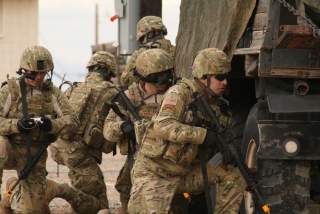Is the Army's Multicam Camouflage Good or a Just Trend?
Let's find out.
Key point: Camoflague needs to reflect the environments that soldiers are fighting in.
Thirty years ago, if you looked at a picture of a multinational field exercise involving the United States and the UK, it would be fairly straightforward to tell apart the soldiers from America and the UK. U.S. soldiers would be clad in the M81 woodland pattern, and the British would be clad in their distinctive DPM pattern.
Fast forward to today: Both the UK and the U.S. field patterns are very similar to each other. The U.S. Army has now standardized on Operational Camouflage Pattern (OCP), a variant of Crye Precision’s Multicam. Likewise, the British Army has standardized on MTP, also a partial variant of Multicam. Special operators from practically every NATO nation use the pattern, and even Russia’s special operators have been seen decked out in it. To the untrained eye, a lot of modern soldiers may look practically identical.
But is the dominance of Multicam a function of the environments soldiers have found themselves deployed in nowadays? Or is it a “trend” of sorts? Will we see militaries continue to move to the pattern, or has the trend past its peak?
While the pattern existed since the early 2000s, Multicam really rose to prominence later that decade. In 2009, a Congressional committee indicated that “soldiers deployed to Afghanistan have serious concerns about the current combat uniform which they indicate provides ineffective camouflage given the environment in Afghanistan”. As a result, the U.S. Congress mandated that the Army choose a better pattern and implement it ASAP.
Multicam was already selected by some Special Operation Forces to be used in Afghanistan, so it was the natural front-runner in this rapid selection process. As a result, Crye Multicam was adopted by the US Army in 2010 as OEF-CP, referencing the theatre to which soldiers wearing the new uniforms would be deployed.
From that point, Multicam simply took off. The British commissioned Crye to create a pattern for them, which applied the Multicam color palette to a variant of the existing DPM pattern. The resulting MTP, while utilizing different shapes from traditional Multicam, still looks very similar.
Many other nations began adopting Multicam at this point, such as Australia and Montenegro who adopted it as a standard pattern. Many more nations issued Multicam on a limited basis to troops deploying to Afghanistan, although many units have begun replacing their regular patterns with Multicam following those deployments.
Even Russia has used adopted Multicam in its more elite units, which have shown a preference for Western gear and equipment. That being said, Russian use of Western patterns in elite units has prior precedent, with Russian clones of the British DPM pattern seeing wide usage prior.
Could the wide adoption of Multicam result in problems with soldiers not being able to tell each other apart in the field? It’s possible but unlikely. The general shape and loadout of a soldier will remain somewhat distinct, and various visual ID tells are usually worn to make identifying friendlies easier such as IR strobes, armbands, or tactical recognition flashes on uniforms.
But is Multicam the “end of the line” for camouflage development before the move to active camouflage and other next generation camos? Probably not. Even by 2013, Crye Precision themselves recognized the shortcomings of the regular Multicam pattern and launched variations of the pattern for Arid, Tropic and Winter terrain.
Recommended: What Will the Sixth-Generation Jet Fighter Look Like?
Recommended: Imagine a U.S. Air Force That Never Built the B-52 Bomber
Recommended: Russia's Next Big Military Sale - To Mexico?
The basic pattern works very well a wide variety of locations where recent conflicts have occurred, including Syria, Afghanistan, and even Ukraine, but the pattern falls short when it comes to areas where vegetation is more lush and dense or more sandy. Countries who have militaries that primarily operate in those environments are likely to continue using their existing patterns or develop new ones of their own, instead of licensing specific versions of Multicam.
For example, the Austrian Bundesheer recently moved from their old solid green to a new indigenous pattern. Germany also is fielding a new (lighter) pattern, Multitarn, that’s closer to Multicam’s palette. France is sticking with their 1980s Central European Camouflage pattern in their new uniform. The majority of Russian forces are likely to stick with EMR (known in the west as Digiflora), despite the use of Multicam by more elite forces due to its greater effectiveness in the darker green woods of Russia.
Multicam and patterns inspired by it will probably continue to be worn in environments in which it works well, but as militaries revert back from expeditionary roles and return focus to defending their own borders, the camouflage will likely become less widespread.
Charlie Gao studied political and computer science at Grinnell College and is a frequent commentator on defense and national security issues. This first appeared in October 2018.

